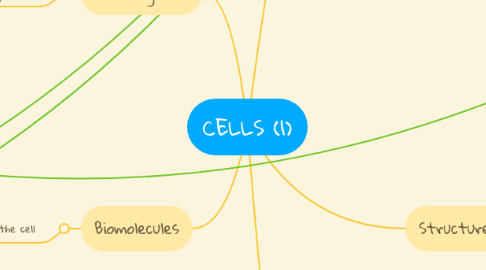
1. Bioenergetics
1.1. The transformation of energy that occurs in living organisms
1.1.1. Endergonic Reaction
1.1.1.1. Requires energy
1.1.1.1.1. Photosynthesis
1.1.2. Exergonic Reaction
1.1.2.1. Releases energy
1.1.2.1.1. Cellular Respiration
2. Biomolecules
2.1. Biomolecules, aka macromolecules, are molecules produced by the cell
2.1.1. Carbohydrates
2.1.1.1. Monomer: Monosaccharides
2.1.1.2. It is the quickest energy source
2.1.2. Lipids
2.1.2.1. Monomer: Fatty acids and glycerol
2.1.2.2. Can be used as alternative source of energy and can provide insulation
2.1.2.3. Non polar
2.1.3. Proteins
2.1.3.1. Monomer: Amino acids
2.1.3.2. Composed of chains of amino acids that is essential in muscle development
2.1.4. Nucleic Acids
2.1.4.1. Monomer: Nucleotides
2.1.4.2. Essential in directing the protein synthesis
2.1.4.2.1. DNA
2.1.4.2.2. RNA
3. Division and Reproduction
3.1. Eukaryotes
3.1.1. Mitosis
3.1.1.1. A parent cell divides into two identical cells
3.1.2. Meiosis
3.1.2.1. A process which occurs in gametes. A parent cell divides twice to produce 4 varying daughter cells
3.2. Prokaryotes
3.2.1. Binary Fission
3.2.1.1. The cell's genetic material (DNA) is duplicated and then the cell elongates then the septum forms and the cell pinches into two
4. Structure and Functions
4.1. Eukaryotic Cells
4.1.1. Plant Cell
4.1.1.1. Cell Wall
4.1.1.1.1. Outer layer of the cell that provides support
4.1.1.2. Chloroplast
4.1.1.2.1. Contains the chlorophyll which is the site of photosynthesis. It is the site of photosynthesis
4.1.1.3. Central Vacuole
4.1.1.3.1. Storage compartment for water, sugar, ions, and pigments.
4.1.1.4. Plasmodesmata
4.1.1.4.1. Openings in the cell wall that functions during cell-to-cell communication
4.1.2. Common Organelles
4.1.2.1. Plasma Membrane
4.1.2.1.1. Lipid bilayer in which proteins are embedded
4.1.2.2. Cytoplasm
4.1.2.2.1. Semifluid matrix that contains the nucleus and other organelles
4.1.2.3. Mitochondria
4.1.2.3.1. Powerhouse of the cell
4.1.2.4. Cytoskeleton
4.1.2.4.1. Supports the organelles as well as the cell shape and it also plays a role in cell motion
4.1.2.5. Nucleus
4.1.2.5.1. It is the command center of the cell. It also contains the hereditary information of the cell
4.1.2.6. Endoplasmic Reticulum
4.1.2.6.1. Smooth ER
4.1.2.6.2. Rough ER
4.1.2.7. Golgi Apparatus
4.1.2.7.1. Collects, packages, and distributes molecules manufactured in the cell
4.1.2.8. Peroxisome
4.1.2.8.1. Vesicle that contain enzymes that carry out particular reaction such as detoxifying potentially harmful molecules
4.1.2.9. Lysosome
4.1.2.9.1. Vesicle that breaks down macromolecules and digests worn out cell components
4.1.3. Animal Cell
4.1.3.1. Centriole
4.1.3.1.1. Complex assembly of microtubules that occurs in pairs
4.2. Prokaryotic Cells
4.2.1. Cell Wall
4.2.1.1. Protects the cell and provides support and shape
4.2.2. Cytoplasm
4.2.2.1. Gel like substance that contains enzymes, salts, cell components, and other organic molecules
4.2.3. Cell Membrane
4.2.3.1. It surrounds the cell's cytoplasm and regulates the flow of substances
4.2.4. Pili
4.2.4.1. Hair-like structures that allows the cell to attach to other cells and surfaces.
4.2.5. Flagella
4.2.5.1. Long, whip-like protrutions that helps in cell locomotion
4.2.6. Ribosomes
4.2.6.1. Cell structure that is responsible for protein production
4.2.7. Plasmids
4.2.7.1. Circular DNA structures that carries the genes
4.2.8. Nucleoid Region
4.2.8.1. Region that contains the single bacterial DNA molecule
4.2.9. Capsule
4.2.9.1. Additional covering to the cell
5. Transport Mechanism
5.1. Occurs in the plasma membrane, its function is to maintain homeostasis
5.1.1. Active Transport
5.1.1.1. Uses energy (ATP)
5.1.1.1.1. Endocytosis
5.1.1.1.2. Exocytosis
5.1.1.1.3. Sodium-Potassium Pump
5.1.2. Passive Transport
5.1.2.1. Doesn't use energy
5.1.2.1.1. Simple diffusion
5.1.2.1.2. Facilitated diffusion
5.1.2.1.3. Osmosis
